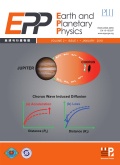- 钛学术文献服务平台 \
- 学术期刊 \
- 基础科学期刊 \
- 天文学、地球科学期刊 \
- 地球与行星物理(英文)期刊 \
Proton belt variations traced back to Fengyun-1C satellite observations
Proton belt variations traced back to Fengyun-1C satellite observations
基本信息来源于合作网站,原文需代理用户跳转至来源网站获取
摘要:
We used historical data to trace trapped protons observed by the Fengyun-1C (FY-1C) satellite at low Earth orbits (~800 km) and chose data at 5–10 MeV, 10–40 MeV, 40–100 MeV, and ~100–300 MeV from 25 March to 18 April 2000 to analyze the proton variations. Only one isolated strong storm was associated with a solar proton event during this period, and there was no influence from previous proton variations. Complex dynamic phenomena of proton trapping and loss were affected by this disturbance differently depending on the energy and L location. The flux of 5–10 MeV protons increased and created new trapping with a maximum at L ~2.0, and the peak flux was significantly higher than that at the center of the South Atlantic Anomaly. However, at higher L, the flux showed obvious loss, with retreat of the outer boundary from L ~2.7 to L ~2.5. The increase in the 10–40 MeV proton flux was similar to that of the 5–10 MeV flux; however, the peak flux intensity was lower than that at the center of the South Atlantic Anomaly. The loss of the 10–40 MeV proton flux was closer to the Earth side, and the outer boundary was reduced from L ~2.3 to L ~2.25. For the higher energy protons of 40–100 MeV and 100–300 MeV, no new trapping was found. Loss of the 40–100 MeV protons was observed, and the outer boundary shifted from L ~2.0 to L ~1.9. Loss was not obvious for the 100–400 MeV protons, which were distributed within L < 1.8. New proton trapping was more likely to be created at lower energy in the region of solar proton injection by the strong magnetic storm, whereas loss occurred in a wide energy range and reduced the outer boundary on the Earth side. Similar dynamic changes were observed by the NOAA-15 satellite in the same period, but the FY-1C satellite observed more complex changes in lower energy protons. These results revealed that the dynamic behavior of protons with different L-shells was due to differences in the pitch angle. Possible mechanisms related to new trapping and loss are also discussed. These mechanisms are very important for understanding the behavior of the proton belt in the coming solar cycle.

推荐文章
Test the topographic steady state in an active mountain belt
Taiwan
Uplift
Denudation
River profile
Sediment yield
In-situ 10Be
Vital effects of K isotope fractionation in organisms: observations and a hypothesis
K isotopes
Isotope fractionation
Vital effects
浅析基于车载以太网的BACK-TO-BACK电路板设计
以太网
BACK-TO-BACK电路板
连通性
传输速率
Geochemical constraints on the tectonic setting of the Sonakhan Greenstone Belt, Bastar Craton, Cent
Supra-subduction
Neo-Archean
Sonakhan Greenstone terrain
Bastar craton
内容分析
关键词云
关键词热度
相关文献总数
(/次)
(/年)
文献信息
| 篇名 | Proton belt variations traced back to Fengyun-1C satellite observations | ||
| 来源期刊 | Earth and Planetary Physics | 学科 | |
| 关键词 | |||
| 年,卷(期) | 2020,(6) | 所属期刊栏目 | |
| 研究方向 | 页码范围 | 611-618 | |
| 页数 | 8页 | 分类号 | SPACE PHYSICS: MAGNETOSPHERIC PHYSICS |
| 字数 | 语种 | 英文 | |
| DOI | 10.26464/epp2020069 | ||
五维指标
引文网络
引文网络
二级参考文献 (0)
共引文献 (0)
参考文献 (0)
节点文献
引证文献 (0)
同被引文献 (0)
二级引证文献 (0)
2020(0)
- 参考文献(0)
- 二级参考文献(0)
- 引证文献(0)
- 二级引证文献(0)
引文网络交叉学科
相关学者/机构
期刊影响力
地球与行星物理(英文)
主办单位:
中国地球物理学会
中国科学院地质与地球物理研究所
中国科技出版传媒股份有限公司
出版周期:
双月刊
ISSN:
2096-3955
CN:
10-1502/P
开本:
大16开
出版地:
北京朝阳区北土城西路19号地质与地球所
邮发代号:
创刊时间:
2017
语种:
eng
出版文献量(篇)
263
总下载数(次)
0
总被引数(次)
126
期刊文献
相关文献
推荐文献

 免费查重
免费查重










